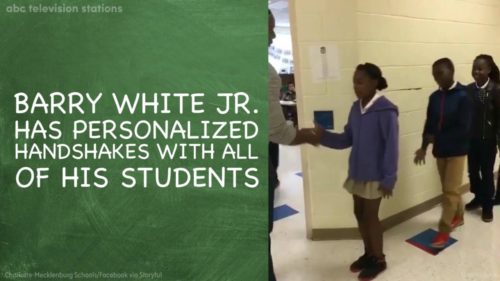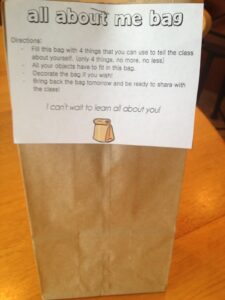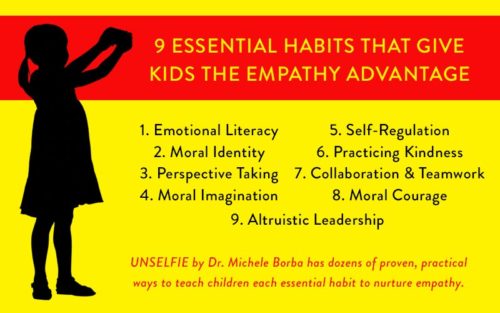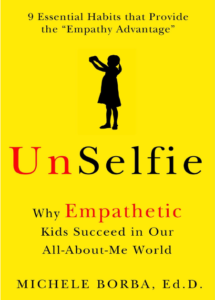Empathy Habit 1. EMOTIONAL LITERACY Empathy Habit 6. DEVELOPING & EXERCISING COMPASSION
From UnSelfie: Why Empathetic Kids Succeed in Our All-About-Me World
Reality Check: Improving students’ relationships with teachers has important, positive and long-lasting implications for both students’ academic, social and moral development, and is often the key over-looked curriculum.
The crucial element about any classroom is the strength of the relationship between the students and the teacher. Empathy is the foundation to learning, and students always learn best from those they trust, respect and care about.
Research confirms that respectful relationships amongst students and teachers are important to establishing a positive, respectful school climate. Effective classroom management also begins with empathy and respect. If a teacher has a good relationship with students, they are better behaved, accept and follow the rules and procedures, show up on time, and are less likely to drop out.
The truth is no curriculum, standards, content, training, scheduling or textbook trumps a caring teacher-student relationship when it comes to learning success.Theodore Roosevelt may have said it best: “They don’t care how much you know until they know how much you care.”
Here are 21 simple, no cost ways to build connections with students, develop caring relationships and create inclusive learning environments. Choose those that work best with your class size or teaching situation.
Assess Your Connections
Your first step to building student-teacher relationships is to do an honest assessment as to just how well you know them. Ask yourself: which strategies am I already using to build relationships? And which students might I be unintentionally overlooking? After the first few opening days of school, assess who you still may not know via name or knowledge of any personal interests. Depending on class or school size, here are a few ways to assess connections.
Relationship Assessment Wall. As class and school sizes increase we can miss marginalized students. Not in one large Alaskan high school! The whole staff created a large wall space in their staff room that was designated as a “Staff-Student Relationship Assessment Wall.” Their goal was to track which students staff members knew personally – beyond grades and achievement scores. The name of each student was printed at the top of a post-it, alphabetized, and then stuck on the wall. Each educator was then asked to take a few minutes and put a check mark on those post-its representing student that they knew something about – like their interests, family life, learning styles, problems, joys, concerns, friends, and outside activities. At the end of the week, the staff reviewed which students had no check marks. The staff vowed to create personal relationships with those teens until slowly all the post-its had check marks.
Walk Your Halls. Your students may feel a connection with you, but how are they doing outside your room? Ever so often, pop your head into the cafeteria, hallways, quad, playgrounds, library, or bathrooms. Look for your students and then check their demeanor. Do they appear happy or gloomy? Are they alone or with friends? Which students are included and which are marginalized? Those findings can help you understand why some students walk into your class appearing stressed or upset. In some cases, you may need to help them find “safe zones” like the library, counselor’s office, or your room when class is not in session. Do pass on your concerns to other staff, counselors and psychologists to help them build connections and help students who are hurting.
Track Who You Call On and Where You Stand. Where is the spot you are most likely to stand in your class? TESA studies tell us that where our students sit in relation to where we teach has much to do with how often they will be acknowledged or called on. So, think about who you typically call upon more often. A simple way to find out is by putting a clear transparency sheet over your seating chart. Then use a transparency pen to check students’ names that you call or connect with. Track your behavior for a week. Then start calling on those students who are missing your marks. Move closer to those students to form more caring relationships. Acknowledge their efforts. Ask “How ya doing?” Other ideas to help you not overlook students:
• Move the rows. Use a rotating seating chart so that your back row moves up to the front row each week. We’re more likely to connect with kids in the front row-or where we stand most. So, move students to you.
• The Chosen Few. Each day write a few students names on post-it notes. Those students who the ones you’ll make brief encounters during the day or class period. The number you choose is whatever is realistic.Some teachers write the name of each student on a popsicle stick, and then randomly pull a few names each day for short personal chats.
• Names on Index cards. Write the name of each student on a separate index card. If you teach different students per period, use a different colored card per period. Then each day pull a few cards, and those students are the ones you’ll personally talk to, greet, call on, conference with… for “minute caring encounters” or academic questions.
End of the Week Check-Up
Depending on your student load, quiz yourself to see how well you know your students.
Week 1: Don’t look at your roster, but try to list all students in each class. Now compare your list to the roster. Which ones did you miss? Jot down their names and make a point to get to know their names, faces and interests.
Week 2 (or Week 3): Pull out your class list for each period. Try to write one personal interest or strength you know about each student. Which students do you not know anything about on a personal or positive basis? Make a conscious effort to find out more about those students during the coming weeks.
Create Caring Class Rituals

Greet Students At The Door. Over the year I’ve conducted focus groups with hundreds of students to assess their perceptions of school safety. Their top advice: “Tell the teachers to stand at the door and greet us when we come in. It makes us feel safer and feel like they care about us.” So, when the bell rings, be at the door. Greet each student with a smile and a “hello.” Some teachers create their own greeting routines.
H & H: My first grade teacher did a daily “H or H” – each of us was to choose a high five or a handshake from her. We loved it! She later extended the activity to have short chats with us and give genuine compliments. It was a great way to model social skills.
Special Handshake: A middle school teacher told me he develops a unique handshake each week to greet his students. His students can’t wait to see his new creation. Barry White, Jr. has a personalized handshake for each student and became a Youtube sensation and guest on TODAY. Develop your own handshake or greeting.
Stand at the entrance: Principals stand at the curb and greet students when they first step onto school grounds.Be there!
A CLASS TWITTER FEED
Set up a private twitter account for your class for only you, your students, their parents and administration. Then each night send at least one tweet about what you enjoyed about the day or are looking forward to during the coming week.
Find Out Personal Interests
Recognizing your students’ interests shows them that you care about them personally but will also help you create examples to match their passions. For instance, if a student who loves hockey comes to you with a math question, you could respond with an example involving hockey. Or if a student who you know loves guitar and is struggling to find friends, you could encourage the child to join the school guitar club. Tune in closer. Listen and acknowledge interests!
Biographical Cards. Provide each student with a 3×5: index card which will become your record of their interests, strengths, concerns as well as personal data file. For middle or secondary levels, use a different color card for each class period (yellow: first period; blue: second period, etc). Tell students to write pertinent information (name, phone, email, birthday, home address) at the top of their card. Then ask them to write three to six facts that they would like you to know (such as their hobbies, interests, birthplace, number of siblings, as well as “One thing you would like me to know about you.” Stress that no one but you will read the cards. Now use the completed cards to take attendance. They will help you learn personal facts about your students. Add additional discoveries on the back of each student’s card throughout the year to develop stronger relationships.
Pass On Card Packs. A staff at a Utah elementary school varied the Biographical Cards by keeping the packs per class or subject on metal rings. The staff continued to note “personal findings” about students throughout the year. Then the staff passed the cards onto each student’s new teacher. A middle school made duplicate sets of cards to pass on to multiple teachers.
Ask: “What Do You Wish My Teacher Knew?” “My dad is deploying next week.” “I hate to speak in front of a group.” “I don’t have anybody to eat with at lunch.” “My mom has cancer.” “I’m afraid I’m going to miss the bus.” Many students have concerns that don’t have anything to do with subject content. Those struggles make big differences on their learning and mental well-being. Give each student a 3×5 card. Stress that no one but you will read those cards. “Write the one thing you wish I knew about you that would help me be a better teacher” and sign it. A few may divulge information that could be transformational in helping you reach and teach them.
“What’s Your Favorite?” Survey. Another way to find out students’ interests is to give each a 5-10 item survey entitled: “What’s Your Favorite?” Younger students can draw answers. Items could include: What’s your favorite: book, movie, hero, hobby, instrument, song, subject, sport, game, person, TV show, etc. One teacher asks her students to bring in a photo (or drawing) showing the activity. Another teacher turns the survey into a bulletin board that shows his favorites.
 “Me” Paper Bags. Give each student a small lunch-size brown bag and ask them to return it the following day filled with one object (or several) that describes a favorite hobby, joy, or interest. The artifact could be something they enjoy like a baseball, a favorite CD, photo of a vacation spot, a favorite food wrapper, a favorite book, etc., but must fit in the bag and not be valuable so as not to cause distress if lost or broken.
“Me” Paper Bags. Give each student a small lunch-size brown bag and ask them to return it the following day filled with one object (or several) that describes a favorite hobby, joy, or interest. The artifact could be something they enjoy like a baseball, a favorite CD, photo of a vacation spot, a favorite food wrapper, a favorite book, etc., but must fit in the bag and not be valuable so as not to cause distress if lost or broken.
Some teachers put the bags in the middle of the room, and then students guess which object belongs to each student. Other teachers have students do a one minute introduction of themselves using the object or use the props for an All About Me essay. Do include yourself in the activity by filling up a bag so that you share yourself with your students.
Create Ways to Personally Connect
One Minute Conference. Each day or class period, set aside one minute to meet with a different student (at their desk or yours) while other students are completing assigned academic tasks. The meeting can be a personal conversation (“How are things going?” “What was the score of your game?” “When will you be moving?”) or feedback on an assignment : “Good job on…. (describe a strength in their past academic work).” “Next time you might consider…” “If you did this one thing it would improve your performance…” Then track your conferences in your record book, so that by the end of each month you personally confer with at least 20 students. Hint: Depending on the size of your classes, some teachers do two or more student one minute conferences per day.
Drop a Post-It. Keep a stack of Post-it notes handy. Whenever you discover something about a student or notice that he deserves recognition, just jot the finding on the note and leave it on his desk. “I just heard that you won your soccer game! Good going!” “Good luck on the concert tonight. I know you’ve put a lot of time into your rehearsals.” “You are a great artist! You should always draw out your thoughts like that!” If you missed the opportunity during class time, then just add a line to the end of the student’s paper that you’re correcting. The ritual helps you tune into your students’ interests and strengths.

Quick Chat Notebooks. Teacher-Student Journals are a way to create relationships through writing. Each student writes in an ongoing composition notebook about an assigned topic (Something I’m looking forward to this weekend; My favorite part of the book; A goal I’m struggling with) and the teacher responds in a few sentences.
A variation is a Quick Chat Notebook between teacher and student. Each child has a small bound notebook about 3″ by 7″ (or smaller). The notebook is used anytime a student has a question or wants to share something personal and then leaves it in a designated box. The teacher responds in writing and delivers the notebook to the student during class. The notebooks are always confidential and can be a great way to dialogue with more reserved students.
Teacher Mail Box. A high school teacher told me that he knows that some students are too intimidated to ask for help, and even if they did , there often isn’t time. So, he keeps a mailbox (yes, a real one that he found at a garage sale) on his desk. “Anytime you have a question or suggestion and you’re more comfortable writing it, just jot me a note, put in the box, and put up the flag. Make sure you sign it, and I’ll get back to you.” And the teacher does: either by writing a note back and delivering it during class time or setting up a mini-conference with the student before, during class or after school. Connection!
“Great teachers focus not on compliance, but on connections and relationships.” – P.J. Caposey, Education Week
There are dozens of ways to connect with students. The key is to find the strategy that works best for you and your comfort zone, and then turn it into a routine.
Building student-teacher relationships has always been important, but especially for today’s digital natives. Research shows they are plugged-in, but also lonelier, more individualistic, and far lower in empathy levels than any previous generation. While greeting students at the door and finding out how their lives may not be part of our lesson plans, those small connecting moments are often what students need most to start their day. After all, every child needs a champion. May that champion be you!
UnSelfie: Why Empathetic Kids Succeed in Our All About Me World provides a nine-step framework for teaching empathy to our children. The first step is always creating a trust, inclusive environment. The ideas in this post depicted Empathy Habit 1: Teaching Emotional Literacy and Empathy Habit 6: Developing and Exercising Compassion Every Day.

Join the #UnSelfie Revolution to Raise Kids With Empathy, Moral Conviction and Courage Who Want to Make a Better World
 I’ll share proven ways in this blog that we can use to cultivate our children’s empathy and switch their attitudes from WE, not ME. The ideas from this post are adapted from my latest book, UnSelfie: Why Empathetic Kids Succeed in Our All About Me World which describes how to cultivate the Nine Crucial Habits of Empathy, and offers dozens of proven ways to do so from toddlers to teens.
I’ll share proven ways in this blog that we can use to cultivate our children’s empathy and switch their attitudes from WE, not ME. The ideas from this post are adapted from my latest book, UnSelfie: Why Empathetic Kids Succeed in Our All About Me World which describes how to cultivate the Nine Crucial Habits of Empathy, and offers dozens of proven ways to do so from toddlers to teens.
Follow me on Twitter @MicheleBorba or on my website MicheleBorba.com for over 500 blogs on character and empathy building as well as how to contact me for speaking. You may also enjoy:
50 Books for Kids and Teens That Teach Empathy
3 Ways to Teach Perspective-Taking
10 Ways to Raise a Charitable Child
Empathy Is a Verb: My TEDx Talk
6 Ways to Inspire Kids To Make a Difference
8 Ways to Help Kids Develop Caring Mindsets
7 Ways to Teach Perspective Taking and Stretch Students’ Empathy Muscles!

